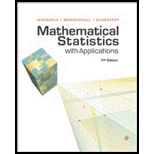
a.
Find the marginal density
Identify the densities.
a.
Answer to Problem 25E
The marginal density function for
Explanation of Solution
Calculation:
Consider that
Then, the marginal probability functions of
Hence, the marginal probability density function for
Thus, the marginal density function for
In similar way, the marginal probability density function for
Thus, the marginal density function for
Gamma function:
A random variable Y is said to follow a Gamma distribution with parameter
Where
Hence, comparing with the probability density function of Gamma function the marginal density function for
b.
Find the values of
b.
Answer to Problem 25E
The value of both
Explanation of Solution
From Part (a), marginal density function for
Hence,
Thus,
From Part (b), marginal density function for
Hence,
Thus,
c.
Find the values of
c.
Answer to Problem 25E
The values of
Explanation of Solution
Calculation:
Conditional distribution and density function:
Consider that
Now, the conditional distribution function of
Now, for any
Similarly, for any
In the given problem the range of both
Hence, the values of
d.
Find the conditional density function of
d.
Answer to Problem 25E
The conditional density function of
Explanation of Solution
Calculation:
Using the joint probability density function of
Hence, the conditional density function of
e.
Find the conditional density function of
e.
Answer to Problem 25E
The conditional density function of
Explanation of Solution
Calculation:
Using the joint probability density function of
Hence, the conditional density function of
f.
Compare the marginal density function
f.
Explanation of Solution
From Part (d), conditional density function of
From Part (a), the marginal density function for
Hence,
Thus, it can be said that
g.
Explain the meaning of the answer in Part (f) regarding the implication of the marginal and conditional probabilities that
g.
Explanation of Solution
From Part (f), it is obtained that
Hence, it can be said the marginal probability of
Want to see more full solutions like this?
Chapter 5 Solutions
Mathematical Statistics with Applications
- A company found that the daily sales revenue of its flagship product follows a normal distribution with a mean of $4500 and a standard deviation of $450. The company defines a "high-sales day" that is, any day with sales exceeding $4800. please provide a step by step on how to get the answers in excel Q: What percentage of days can the company expect to have "high-sales days" or sales greater than $4800? Q: What is the sales revenue threshold for the bottom 10% of days? (please note that 10% refers to the probability/area under bell curve towards the lower tail of bell curve) Provide answers in the yellow cellsarrow_forwardFind the critical value for a left-tailed test using the F distribution with a 0.025, degrees of freedom in the numerator=12, and degrees of freedom in the denominator = 50. A portion of the table of critical values of the F-distribution is provided. Click the icon to view the partial table of critical values of the F-distribution. What is the critical value? (Round to two decimal places as needed.)arrow_forwardA retail store manager claims that the average daily sales of the store are $1,500. You aim to test whether the actual average daily sales differ significantly from this claimed value. You can provide your answer by inserting a text box and the answer must include: Null hypothesis, Alternative hypothesis, Show answer (output table/summary table), and Conclusion based on the P value. Showing the calculation is a must. If calculation is missing,so please provide a step by step on the answers Numerical answers in the yellow cellsarrow_forward
- Algebra & Trigonometry with Analytic GeometryAlgebraISBN:9781133382119Author:SwokowskiPublisher:Cengage
 Elements Of Modern AlgebraAlgebraISBN:9781285463230Author:Gilbert, Linda, JimmiePublisher:Cengage Learning,
Elements Of Modern AlgebraAlgebraISBN:9781285463230Author:Gilbert, Linda, JimmiePublisher:Cengage Learning,

